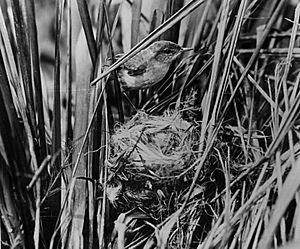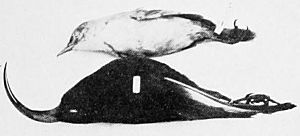Laysan millerbird facts for kids
Quick facts for kids Laysan millerbird |
|
|---|---|
 |
|
| Photo taken by Walker K. Fisher in May 1902 | |
| Conservation status | |
|
Extinct (late 1910s)
|
|
| Scientific classification |
|
| Kingdom: | Animalia |
| Phylum: | Chordata |
| Class: | Aves |
| Order: | Passeriformes |
| Family: | Acrocephalidae |
| Genus: | Acrocephalus |
| Species: | |
| Subspecies: |
†A. f. familiaris
|
| Trinomial name | |
| Acrocephalus familiaris familiaris (Rothschild, 1892)
|
|
| Synonyms | |
|
Tartare familiaris Rothschild, 1892 |
|
The Laysan millerbird (Acrocephalus familiaris familiaris) was a small bird that lived only on Laysan Island in the Hawaiian Islands. It was a type of millerbird, much like its cousin, the Nihoa millerbird, which still lives today. This bird had a brown back and a grayish belly.
It got its name, "millerbird," because it loved to eat certain kinds of moths. These moths were often called "millers" because their wings looked like they were covered in flour, just like a miller's clothes. Sadly, the Laysan millerbird is now extinct, meaning it no longer exists.
Why the Laysan Millerbird Disappeared

The Laysan millerbird was a very friendly and calm bird. In the 1890s, there were many of them on Laysan Island, which was their only home.
However, things changed when domestic rabbits were brought to the island in 1903. These rabbits ate almost all the plants on Laysan Island within a few years. This loss of plants caused big problems for the millerbirds.
The Decline of the Millerbird Population
After the rabbits destroyed the plants, the number of millerbirds quickly dropped. Some reports from 1915 suggested there were still 1500 birds, but earlier visits in 1911 and 1916 found only a few. It's possible that some birds were also caught for the Japanese hat-making trade around that time.
By 1923, an expedition to the island found no confirmed sightings of the Laysan millerbird. This means the bird likely disappeared completely in the late 1910s.
Challenges for Survival
As the plants on Laysan Island vanished, the millerbirds faced many dangers:
- Egg Predation: Other birds like Laysan finches, ruddy turnstones, and bristle-thighed curlews started eating the millerbird's eggs more often.
- Habitat Loss: There were fewer safe places for the birds to build their nests. Only a small area of tree tobacco plants was left for nesting.
- Food Shortage: The moths that the millerbirds loved to eat also disappeared because their food plants were eaten by the rabbits. The millerbirds then had to compete with other birds and the Laysan duck for brine flies, which were not their main food.
The Laysan millerbird was probably one of the first birds on the island to become extinct due to these challenges. Other birds, like the Laysan rail, also disappeared around the same time.


